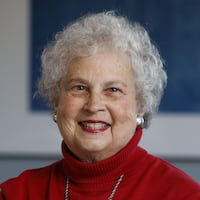Katrina McGhee, executive vice president and chief marketing officer for the Susan G. Komen Breast Cancer Foundation in Dallas, attributes part of the phenomenon to the disease.
“I think it’s the randomness of breast cancer with the two biggest risk factors being female and growing older so that impacts a broad section of people,” said McGhee, who grew up in Trotwood and graduated from Dayton Christian High School. “It impacts our mothers and sisters and daughters and affects the whole family. And unlike many other diseases, we still don’t know what causes it and are still looking for cures.”
One in eight women will be diagnosed with breast cancer in her lifetime, and it represents the largest cancer survivor group, with 2.5 million survivors.
It’s significant to marketers, McGhee said, that the disease impacts a woman’s breast, her femininity and sexuality, and that — unlike many other chronic illnesses — you can see what part of the body is affected.
She calls breast cancer fundraising “the perfect storm.”
“I worked at National Center of the American Heart Association and I know more women die of heart disease annually, but with breast cancer you have that unique mix of a disease that affects outward manifestation, and treatment can be prolonged and arduous.”
Komen founder Nancy Brinker created the “cause marketing” revolution, allowing donors to contribute to a favorite cause by purchasing a product. A Duke University study found that even in difficult times people are up to 74 percent more likely to buy a product if it is supported by a cause.
That idea has really caught on. When McGhee joined Komen four years ago, the organization’s pink ribbon emblem appeared on 100 products. Today there are 200 ranging from coffee carafes and umbrellas to PJ’s and kitchen mixers. Last year, cause-related marketing for Komen alone raised $52 million.
The marketing was further helped by the color pink, a choice Leatrice Eiseman, America’s best-known color consultant, calls “brilliant.” Pink ribbons, now a universal icon, were distributed at the first Komen walks in New York City in the early 1990s.
“First, pink is seen as a healthy color imparting a rosy glow, so there is a good perception in connection with the cause,” Eiseman said. “It is also is a color that works well for female bonding as it has been seen traditionally as a more ‘feminine’ color.”
Breast cancer walks, such as Komen’s “Race for the Cure,” American Cancer Society’s “Making Strides Against Breast Cancer” and “The Avon Walk for Breast Cancer,” further the campaign by helping make a cause personal and get everyone involved, experts said.
“With a click of a mouse, a woman can invite 100 of her friends and family to walk with her,” said Sandra Minnuti, vice president for Charity Navigator, which annually rates 5,500 of the largest charities to help donors make informed giving choices. Eight breast cancer charities have earned Charity Navigator’s top four-star rating, indicating they are financially healthy, efficient with their monies and have shown growth in recent years.
Tricia Davidson of Duffy & Partners worked on brand revitalization for the 25th anniversary of Susan G. Komen for the Cure. She said the organization’s “Race for the Cure” is the largest registered 5K event in the world, with 1.6 million people walking or running in 2009. Over $1 billion has been raised since the group’s inception, with $100 million in research grants given in 2008.
“Whenever you can increase the focus and the number of ways your message is getting to people you are getting make a much larger impression,” she said.
The breast cancer phenomenon demonstrates just how powerful women can be as a force when they join together, Alix Shaer, national director of Making Strides Against Breast Cancer, said.
“Because it’s primarily a women’s disease, there is a sense of camaraderie about it,” Shaer said.
Contact this reporter at (937) 225-2440 or MMoss@DaytonDailyNews.com.
About the Author

